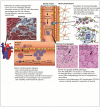Macrophage Polarization in AIDS: Dynamic Interface between Anti-Viral and Anti-Inflammatory Macrophages during Acute and Chronic Infection
- PMID: 26500805
- PMCID: PMC4612489
Macrophage Polarization in AIDS: Dynamic Interface between Anti-Viral and Anti-Inflammatory Macrophages during Acute and Chronic Infection
Abstract
Monocyte and macrophage inflammation in parenchymal tissues during acute and chronic HIV and SIV infection plays a role in early anti-viral immune responses and later in restorative responses. Macrophage polarization is observed in such responses in the central nervous system (CNS) and the heart and cardiac vessels that suggest early responses are M1 type antiviral responses, and later responses favor M2 restorative responses. Macrophage polarization is unique to different tissues and is likely dictated as much by the local microenvironment as well as other inflammatory cells involved in the viral responses. Such polarization is found in HIV infected humans, and the SIV infected animal model of AIDS, and occurs even with effective anti-retroviral therapy. Therapies that directly target macrophage polarization in HIV infection have recently been implemented, as have therapies to directly block traffic and accumulation of macrophages in tissues.
Keywords: Central nervous system; Dorsal root ganglia; Macrophage polarization.
Figures

Similar articles
-
Monocyte/macrophage trafficking in acquired immunodeficiency syndrome encephalitis: lessons from human and nonhuman primate studies.J Neurovirol. 2008 Aug;14(4):318-26. doi: 10.1080/13550280802132857. J Neurovirol. 2008. PMID: 18780233 Free PMC article. Review.
-
Anti-α4 Integrin Antibody Blocks Monocyte/Macrophage Traffic to the Heart and Decreases Cardiac Pathology in a SIV Infection Model of AIDS.J Am Heart Assoc. 2015 Jul 16;4(7):e001932. doi: 10.1161/JAHA.115.001932. J Am Heart Assoc. 2015. PMID: 26185285 Free PMC article.
-
Inhibition of NADPH oxidase 2 enhances resistance to viral neuroinflammation by facilitating M1-polarization of macrophages at the extraneural tissues.J Neuroinflammation. 2024 May 2;21(1):115. doi: 10.1186/s12974-024-03078-8. J Neuroinflammation. 2024. PMID: 38698374 Free PMC article.
-
An SIV macaque model of SIV and HAND: the need for adjunctive therapies in HIV that target activated monocytes and macrophages.J Neurovirol. 2018 Apr;24(2):213-219. doi: 10.1007/s13365-018-0616-6. Epub 2018 Feb 12. J Neurovirol. 2018. PMID: 29435829 Review.
-
M1 Macrophage Polarization Prevails in Epstein-Barr Virus-Infected Children in an Immunoregulatory Environment.J Virol. 2022 Jan 12;96(1):e0143421. doi: 10.1128/JVI.01434-21. Epub 2021 Oct 13. J Virol. 2022. PMID: 34643432 Free PMC article.
Cited by
-
Simian immunodeficiency virus-infected rhesus macaques with AIDS co-develop cardiovascular pathology and encephalitis.Front Immunol. 2023 Oct 27;14:1240946. doi: 10.3389/fimmu.2023.1240946. eCollection 2023. Front Immunol. 2023. PMID: 37965349 Free PMC article.
-
Pathogenic mechanisms of human immunodeficiency virus (HIV)-associated pain.Mol Psychiatry. 2023 Sep;28(9):3613-3624. doi: 10.1038/s41380-023-02294-7. Epub 2023 Oct 19. Mol Psychiatry. 2023. PMID: 37857809 Review.
-
Cystatin B and HIV regulate the STAT-1 signaling circuit in HIV-infected and INF-β-treated human macrophages.J Neurovirol. 2016 Oct;22(5):666-673. doi: 10.1007/s13365-016-0443-6. Epub 2016 May 2. J Neurovirol. 2016. PMID: 27137788 Free PMC article.
-
Pro-inflammatory macrophages suppress HIV replication in humanized mice and ex vivo co-cultures.Front Immunol. 2024 Nov 7;15:1439328. doi: 10.3389/fimmu.2024.1439328. eCollection 2024. Front Immunol. 2024. PMID: 39575258 Free PMC article.
-
An oral form of methylglyoxal-bis-guanylhydrazone reduces monocyte activation and traffic to the dorsal root ganglia in a primate model of HIV-peripheral neuropathy.J Neurovirol. 2017 Aug;23(4):568-576. doi: 10.1007/s13365-017-0529-9. Epub 2017 May 1. J Neurovirol. 2017. PMID: 28462488 Free PMC article.
References
-
- Mills CD, Kincaid K, Alt JM, Heilman MJ, Hill AM. M-1/M-2 macrophages and the Th1/Th2 paradigm. J Immunol. 2000;164:6166–6173. - PubMed
-
- Liddiard K, Taylor PR. Understanding local macrophage phenotypes in disease: shape-shifting macrophages. Nat Med. 2015;21:119–120. - PubMed
-
- Wolfs IM, Donners MM, de Winther MP. Differentiation factors and cytokines in the atherosclerotic plaque micro-environment as a trigger for macrophage polarisation. Thromb Haemost. 2011;106:763–771. - PubMed
Grants and funding
LinkOut - more resources
Full Text Sources
